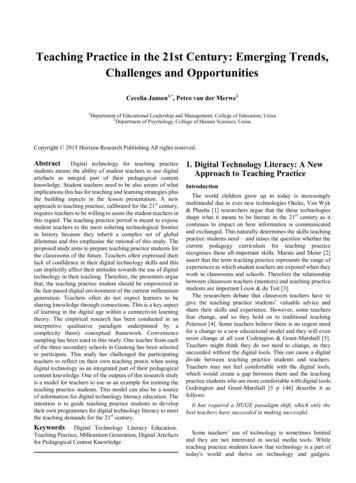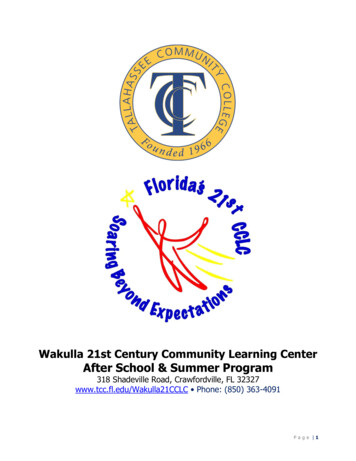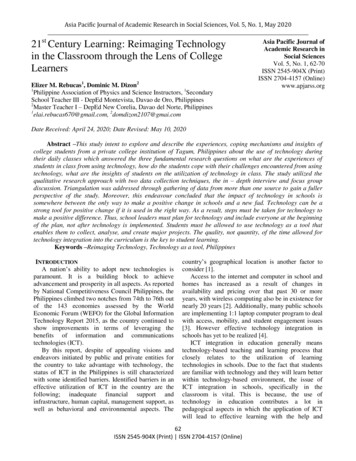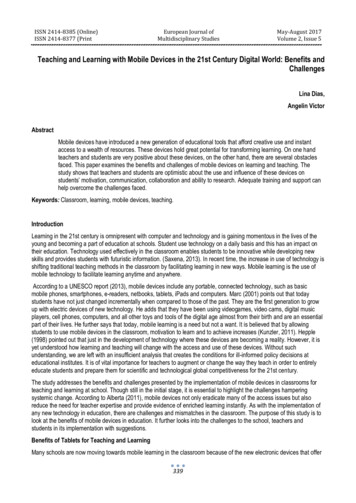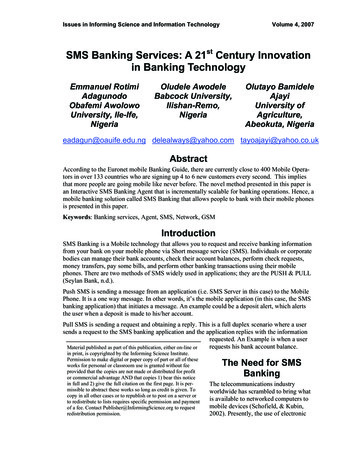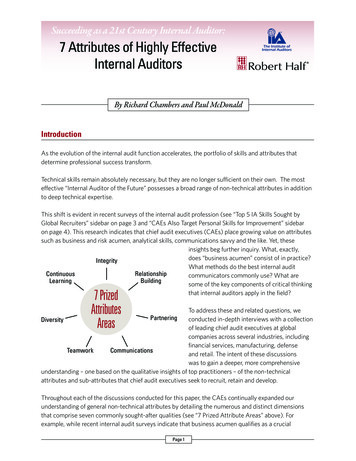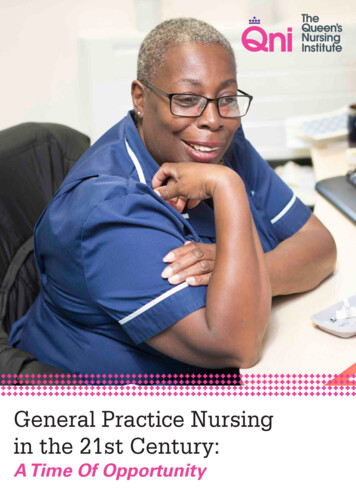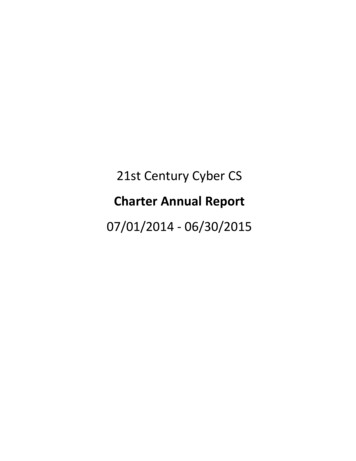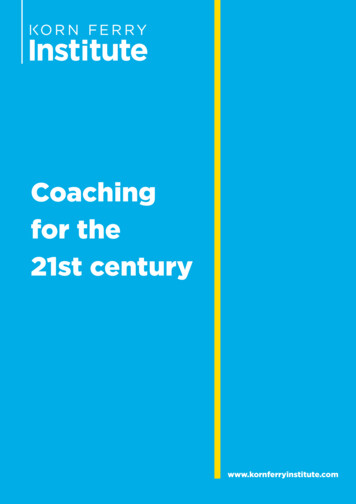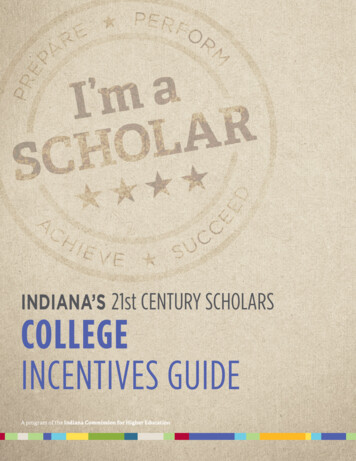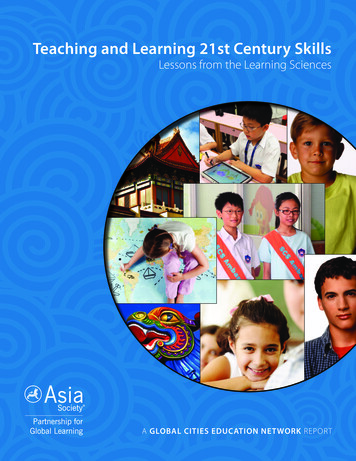
Transcription
Teaching and Learning 21st Century SkillsLessons from the Learning SciencesA GLOBAL CITIES EDUCATION NET WORK REPORT
eLearningSciencesRANDCorporation,April2012Anna Rosefsky Saavedra, RAND CorporationV. Darleen Opfer, RAND CorporationWith many thanks to Tony Jackson, Jessica Kehayes, Jennifer Li, David Perkins, Heather Singmaster, andVivien Stewart for their valuable suggestions.
2TEACHING AND LEARNING -FOREWORDGlobalization of the economy, increasingly diverse and interconnected populations, and rapidtechnological change are posing new and demanding challenges to individuals and societies alike.School systems are rethinking the knowledge and skills students will need for success and theeducational strategies and systems required for all children to achieve them. In both Asia andNorth America, urban school systems are at the locus of change in policy and practice—at oncethe sites of the most-critical challenges in education and the engines of innovation needed toaddress them. Therefore, Asia Society organized the Global Cities Education Network, a networkof urban school systems in North America and Asia, to focus on challenges and opportunities forimprovement common to them, and to virtually all city education systems.A critical element of high-performing school systems is not only that they benchmark thepractices of other countries but that they systematically adapt and implement these practiceswithin their own cultural and political contexts. The Global Cities Education Network is intendedas a mechanism for educators and decisionmakers in Asia and North America to collaborativelydream, design, and deliver internationally informed solutions to common challenges with whicheducation systems are currently grappling.The network engages in cycles of in-depth inquiry, planning, and action to address specific topicsrelated to the themes of transforming learning and achieving equity. Each cycle involvesknowledge sharing and problem solving, including at Global Cities Education Network Symposiaand the production of research and knowledge products, such as case studies, background papers,and meeting reports. The overarching goal is to develop practical wisdom from the research andexperience of the world’s leading experts that reflects proven or promising efforts in networkcities and that can be used to enhance the effectiveness of network and city school systemsworldwide.This report, prepared for the first Asia Society Global Cities Education Network Symposium,held in Hong Kong in May 2012, examines the current definitions of 21st century skills and looksat why and how they should be taught. Asia Society is grateful to the authors, Anna RosefskySaavedra and V. Darleen Opfer of the RAND Corporation, for their support and assistance withthe Global Cities Education Network.We would like to thank the sponsors of the Global Cities Education Network, includingJPMorgan Chase Foundation, MetLife Foundation, Carnegie Corporation, Pearson Foundation,and Hewlett Foundation.We hope that this series of reports provides knowledge and experience useful to cities in Asia,North America, and elsewhere eager to create the conditions that will promote success for allstudents in today’s interconnected world.Tony JacksonVice President, EducationAsia Society
3TEACHING AND LEARNING -CONTENTSIntroduction . 4Defining 21st Century Skills . 4Why Students Need 21st Century Skills . 6Why Are Many Students Not Learning 21st Century Skills? . 7How to Teach 21st Century Skills: Nine Lessons from the Science of Learning . 81.Make It Relevant. 82.Teach Through the Disciplines . 93.Simultaneously Develop Lower- and Higher-Order Thinking Skills . 104.Encourage Transfer of Learning . 115.Teach Students to Learn to Learn . 136.Address Misunderstandings Directly . 147.UnderstandThatTeamwork Is an Outcome and Promotes Learning . 158.Exploit Technology to Support Learning . 169.Foster Students’ Creativity . 17Science of Learning Lessons as 21st Century Skills . 18Assessing 21st Century Skills . 18Formative and Summative Assessments . 18Examples of 21st Century Assessments . 19Meeting the 21st Century Assessment Challenge . 20Building the Capabilities to Teach 21st Century Skills. 20Effective Professional Development Is Critical . 21Schools, as Organizations, Must Support Teachers’ Professional Development . 22Schools Must Become Learning Organizations . 22Moving School Systems Toward 21st Century Education . 23References . 24
4TEACHING AND LEARNING -INTRODUCTIONPreparing students for work, citizenship, and life in the 21st century is complicated.Globalization, technology, migration, international competition, changing markets, andtransnational environmental and political challenges add a new urgency to develop the skills andknowledge students need for success in the 21st century context. Educators, education ministriesand governments, foundations, employers, and researchers refer to these abilities with terms thatinclude “21st century skills,” “higher-order thinking skills,” “deeper learning outcomes,” and“complex thinking and communication skills.” Interest in these skills is not new. For example, formore than 40 years, researchers at Harvard University’s Project Zero have been studying howstudents learn and how to teach these skills. In this paper, we focus on what research tells usabout how students learn 21st century skills and how teachers can effectively teach them.Although all countries believe that the knowledge and skills that students need in the 21st centuryare different from what they have needed in the past, terminology differs between countries, asdoes the emphasized composition of knowledge, skills, and values. We use the term 21st centuryskills because we believe that it is currently the most widely recognized and used terminternationally, though we could just as easily substitute any of the previously mentioned termsfor 21st century skills. Critics denounce the term for being vague and overused,1 for endorsing theidea of teaching skills apart from knowledge, and for promoting skills that have been encouragedfor centuries yet are now emphasized with a new sense of urgency that could lead to rapid andunsuccessful reforms.2In the following sections, we briefly summarize current efforts to define 21st century skills andexplain the economic, civic, and global rationales for why they are important. We attend to thecriticisms leveled against 21st century skills by examining why these skills must be taughtprimarily through disciplinary content, taking care not to “trivialize subject matter”3 and thenidentifying specific ways to do so. The majority of the paper thus focuses on explaining howthese skills should be taught, given what we know about how students learn. We then discuss theassessment of 21st century skills and conclude with an overview of the teacher capacityimplications of institutionalizing “new” teaching and learning processes.DEFINING21STCENTURYSKILLSThere is no shortage of current definitions of 21st century skills and knowledge. In this paper, wedo not seek to provide another or choose one over another. Rather, we share two well-knownexamples and pull out several common themes. In a frequently cited example, the University ofMelbourne–based and Cisco-, Intel-, and Microsoft-funded Assessment and Teaching of 21stCentury Skills (AT21CS) consortium—which includes Australia, Finland, Portugal, Singapore,the United Kingdom, and the United States—organizes 21st century skills, knowledge, andattitudes, values, and ethics into the following four categories: Ways of Thinking: creativity and innovation, critical thinking, problem solving,decisionmaking, and learning to learn (or metacognition)Ways of Working: communication and teamworkTools for Working: general knowledge and information communication technology (ICT)literacy
5TEACHING AND LEARNING - Living in the World: citizenship, life and career, and personal and social responsibility,including cultural awareness and competence.4Another definition comes from the book The Global Achievement Gap by Tony Wagner (2008),co-director of the Harvard Change Leadership Group. Informed by several hundred interviewswith business, nonprofit, and education leaders, Wagner proposes that students need sevensurvival skills to be prepared for 21st century life, work, and citizenship:1. critical thinking and problem solving2. collaboration and leadership3. agility and adaptability4. initiative and entrepreneurialism5. effective oral and written communication6. accessing and analyzing information7. curiosity and imagination.The Asia Society and the U.S. Council of Chief State School Officers specify global competenceas the core capacity students need for the 21st century and define it as the capacity anddisposition to understand and act on issues of global significance. Per this definition, globallycompetent students do the following:1. Investigate the world beyond their immediate environment.2. Recognize perspectives, others’ and their own.3. Communicate ideas effectively with diverse audiences.4. Take action to improve conditions.5These 21st century skill definitions (and others not listed) are cross-disciplinary and relevant tomany aspects of contemporary life in a complex world. They do not currently have a specificplace in most curricula. And most lists of 21st century skills are not entirely composed of skills,by any means. They involve aspects of skill and understanding, but many of them emphasizeinclinations, such as curiosity, creativity, and collaboration, that are not, strictly speaking, skills.Some lists emphasize technology, and others stress attitudes and values more. However, mostfocus on similar types of complex thinking, learning, and communication skills, and all are moredemanding to teach and learn than memorization and other types of rote skills.In recent years, education systems worldwide have also developed frameworks with an increasedemphasis on developing the skills, knowledge, and attitudes necessary for success in the 21stcentury. Table 1 summarizes some of the reforms that have addressed 21st century thinking skills.
6TEACHING AND LEARNING -Table 1. How Education Systems Are Addressing 21st Century SkillsHongKongJapanLearning toLearn reformaddressesappliedlearning and“other”learningexperiences,includingservice andworkplacelearning6Zest for Livingeducation reformstresses theimportance ofexperimentation,problem finding,and problemsolving instead ofrotememorization720002006ChinaGreateremphasis onstudents’ability tocommunicateand work inteams, poseand solveproblems, andlearn to learn82010FinlandSingaporeUnitedStatesNew focus on“citizen skills”:(1) thinkingskills, includingproblemsolving andcreativethinking;(2) ways ofworking andinteracting;(3) crafts andexpressiveskills;(4) participation and initiative;and (5) selfawareness andpersonalresponsibility9NewFrameworkfor 21stCenturyCompetenciesand StudentOutcomes isintended tobetter positionstudents totake advantageof globalopportunities10Common CoreStateStandardsInitiativeredefinesstandards tomake them“inclusive ofrigorouscontent andapplications ofknowledgethroughhigher-orderskills, so thatall students areprepared forthe 21stcentury”11201020102010Although the approaches across national education systems differ, they are similar in recognizingthe need for more-sophisticated thinking and communication skills.WHYSTUDENTSNEED21STCENTURYSKILLSThere are compelling economic and civic reasons for education systems to develop students’ 21stcentury skills. The economic rationale is that computers and machines can cost-effectively do thesorts of jobs that people with only routine knowledge and skills can do, which means that theworkplace needs fewer people with only basic skill sets and more people with higher-orderthinking skills. Further, supply and demand in a global rather than national or local marketplaceincreases competition for workers who can add value through applying nonroutine, complexthinking and communication skills to new problems and environments.There is also a strong civic rationale for schools to increase their focus on developing students’21st century skills. Though students need a foundation of basic civic knowledge, rote learning—recitation of information about government and citizenship—is not a sufficient way to promotecivic engagement. They also need to learn how and why to be engaged citizens who thinkcritically—so that they can, for example, analyze news items, identify biases, and vote in aneducated way. They need to be able to solve problems so they can propose or review policies toaddress social challenges. They need to be able to work with others if they are to effectively serveas jurors or participate in political campaigns. They need to be able to communicate effectivelyorally and in writing so that they can share their opinions publicly, defend their rights, proposenew policy, etc.12 In the U.S. context, engagement in the local and national civic sphere is at anall-time low,13 while increasing inequality—due to the decreasing demand for middle-class jobsthat require only routine knowledge and skills—threatens to weaken commitment to democracy.14
7TEACHING AND LEARNING -Without 21st century skills, citizens cannot exercise the rights and responsibilities that contributeto a healthy societyGlobalization encompasses the third rationale for teaching and learning 21st century skills.15Massive global migration, the Internet, long-haul flights, interdependent international markets,climate instability, international wars, and other factors remind us daily that countries, states, andindividuals are part of a globally interconnected economy, ecosystem, and political network andthat people are part of the global community. This interconnectedness makes it even more urgentfor students around the world to learn how to communicate, collaborate, and solve problems withpeople beyond national boundaries.16These three rationales each motivate the need for 21st century skills from a different perspective,but they are not at odds. Rather, they complement each other because the skills and knowledgenecessary to engage in the economic, civic, and global spheres overlap almost YSKILLS?The dominant approach to compulsory education in much of the world is still the transmissionmodel,17 through which teachers transmit factual knowledge to students through lectures andtextbooks.18 In the U.S. context, for example, the standards and accountability movement thatbegan in the early 1990s led to the development of standards that have been taught predominantlythrough the transmission model and tested through recall-based assessments. Even among manynational board-certified U.S. teachers, the transmission model dominates. 19 Though manycountries are shifting the focus of their educational systems away from this model, it oftenprevails for two primary reasons: because educational systems are hard to change20 and becausethe transmission model demands less disciplinary and pedagogical expertise from teachers thandoes the contrasting “constructivist” model through which students actively—rather thanpassively—gain skills and knowledge. 21 Through the transmission model, students have theopportunity to learn information but typically do not have much practice applying the knowledgeto new contexts, communicating it in complex ways, using it to solve problems, or using it as aplatform to develop creativity. Therefore, it is not the most effective way to teach 21st centuryskills.22A second barrier to students’ development of 21st century skills is that they do not learn them ifthey are not explicitly taught. These skills are not typically taught in separate stand-alone courseson, for example, thinking. We argue below that students should learn 21st century skills throughdisciplinary study so view the lack of stand-alone courses favorably. According to the OECD’s2008 Teaching and Learning International Survey (TALIS), teachers in 22 of 23 participatingcountries—most of which are Northern or Eastern European—favor constructivist pedagogy.However, the TALIS also demonstrates that (in participating countries) 21st century skills are notoften clearly highlighted even when teachers use active learning strategies, such as debate andstructured classroom conversations.23A third impediment is that 21st century skills are more difficult to assess than factual retention.When they are not measured on assessments that have accountability or certification high stakes,teachers tend to reduce their classroom prioritization. As we discuss throughout this paper,development of 21st century skills needs explicit attention.
8TEACHING AND LEARNING ENCEOFLEARNINGDecades of empirical research on how individuals learnsubstantiate critical lessons about the best ways to teach 21stcentury skills. In this paper, we refer to this body of research asthe science of learning.In the following sections, we summarize the science of learningas it relates to learning and teaching 21st century skills andrecommend general lessons that other education systems canapply to move toward similar outcomes. All the lessons areabout how students learn 21st century skills and how pedagogycan address their needs. Many of the lessons—particularlytransfer, metacognition, teamwork, technology, and creativity—are also 21st century skills in themselves.1. MakeItRelevantTo be effective, any curriculum must be relevant to students’lives. 24 Transmission and rote memorization of factualknowledge can make any subject matter seem irrelevant. Inresponse to that model, students memorize information for atest, quickly forget it after the test and then simply look up whatthey need to know on the Internet when they actually need it.This model undermines the possibility of developing students’21st century skills because lack of relevance leads to lack ofmotivation, which leads to decreased learning.25UsingtheScienceofLearningThe science of learning servedas the basis for educationalreforms in Hong Kong andShanghai in 2000 and 2002. Inboth systems, reforms addressstudents as holistic learnersand mobilize widespread socialsupport and appropriatelybalanced centralized versusdecentralized control. Systemlevel curricular pre- and inservice training of teachers andinformation disseminationpolicies in both countries alsosupport the implementation ofpractices derived from thescience of learning. Those twosites correspondingly achievedthe highest scores in the 2009Programme for InternationalStudent Assessment (PISA),which assesses the extent towhich students near the end oftheir compulsory educationhave acquired the skills neededto participate fully in society.To make curriculum relevant, teachers need to begin withgenerative topics, ones that have an important place in the disciplinary or interdisciplinary studyat hand and resonate with learners and teachers.26 Though there are endless generative topicpossibilities, broad examples might include climate change, statistics, and justice. Students andteachers might study implications of climate change for their local area and other areas withsimilar geographic characteristics. They might learn how to use their knowledge of basicstatistical principles to improve their understanding of statistics used in popular press. Theywould not, however, study the justice system from the perspective of governmental facts to bememorized because strong generative topics require student engagement with complex issues.Choosing a generative topic is the first stage of the well-known Teaching for Understandingcurriculum framework, developed through a five-year project by Project Zero researchers andused by teachers worldwide. 27 To choose generative topics, Boix-Mansilla and Jackson 28recommend that teachers ask themselves such questions as “How does this topic connect to thereality of my students’ lives and interests? Am I passionate about the topic myself? If so, why?Are there better ways to frame this topic to make it truly engaging for my students?”
9TEACHING AND LEARNING -As noted in the accompanying text box, the relevance ofspecific topics or issues is clearer to students if it fits withinmeaningful, holistic context, i.e., “the big picture.” Once it isclear to students what the big picture is, they also need tounderstand each of the knowledge-, skill-, and attitude-basedobjectives that contribute to understanding the big picture andwhy they all matter. Developing and conveying to studentseach of these understanding goals is the second step of theTeaching for Understanding model. Through understandingwhat the big picture is, why it matters, and each of the goalsthat will get them there, all the knowledge (concepts, facts,and theories) and skills (methods, tools, and techniques) thatstudents will gain through study of a given generative topicare then relevant.29Both teachers and students benefit from the use of generativetopics and reinforcement of relevance. Teachers like thismethod because it allows for the freedom to teach creatively.Students like it because it makes learning feel moreinteresting and engaging, and they find that understanding issomething they can use, rather than simply possess. 30 Inresponse to the importance of relevance in fostering studentengagement in learning, one of the five goals of Ontario’s2003 Student Success/Learning to 18 Strategy specifiesprovision of “relevant learning opportunities for all students.”Through this reform, the Ministry of Education provides arange of vocational, technical, and accelerated learningopportunities to students that are intended to “match theirstrengths and aspirations.” 312. TeachThroughtheDisciplinesScience-of-learning experts concur that learning should takeplace through the disciplines, including—but not limited to—native and foreign languages, hard and social sciences,mathematics, the arts, and music. As Howard Gardner argues,studentsHelpStudentsSeetheBigPictureTo appreciate the relevance of agiven generative topic, studentsneed to understand the big picture,how pieces fit into the big picture,and why the big picture matters.In his book Making LearningWhole, author David Perkins usesbaseball as an analogy: To playsuccessfully, the players mustknow how hitting, catching, andrunning bases contribute to thegame. Similarly, students need tounderstand how, for example,following the order ofmathematical operations fits intothe bigger picture of mathematicalthinking, and they must have asense of the value of mathematicalthinking in the first place. Perkinsargues for the importance ofexplicitly relating every lesson tothe big picture of the generativetopic under study, whatever thattopic may be. He alsodemonstrates that young learnerscan grasp “junior versions” of thebig picture. For example, a juniorversion of the French Revolutionbig picture could beunderstanding what happens whena few people have all of theresources and power at theexpense of the rest, a lesson thatcould be enacted through aclassroom role-play game.[n]eed an education that is deeply rooted in . . . what is known about the human condition,in its timeless aspects, and what is known about the pressures, challenges andopportunities of the contemporary and coming scene. Without this double anchoring, weare doomed to an education that is dated, partial, naïve, and inadequate.32Learning through disciplines entails learning not only the knowledge of the discipline but also theskills associated with the production of knowledge within the discipline. Through disciplinarycurriculum and instruction students should learn why the discipline is important, how expertscreate new knowledge, and how they communicate about it. Each of these steps maps closely tothe development of 21st century skills and knowledge.33 For example, through scientific study,students should learn why science is relevant and what kinds of problems they can solve throughscientific methods, as well as how scientists carry out experiments, how they reach conclusions,what they do with the knowledge they gain from the process, and how they communicate their
TEACHING AND LEARNING -10findings. Informed by this perspective, to foster students’ enthusiasm for science, technology,engineering, and mathematics (STEM) studies, Japan’s Zest for Living reform legislationincreased emphasis on teaching science and mathematics topics through foundational disciplinarystudy processes like those described above.34Similarly, through historical study, students should learn how to pose a problem they haverealized through familiarity with the historical knowledge base of a given topic. To solve theproblem, they must collect, distill, and synthesize information from oral, written, and visualprimary and secondary sources. They must know where to look for information, whichinformation will help them to construct an argument, how to interpret the information they find,how to structure complex causal relationships, how to account for source biases, and how tocompare and contrast their findings with what has already been presented as historical fact. Theymust also learn how to communicate their findings and practice communicating them to diverseaudiences.Continued learning in any discipline requires that the student—or expert—become deeplyfamiliar with a knowledge base, know how to use that knowledge base, articulate a problem,creatively address the problem, and communicate findings in sophisticated ways.35 Therefore,mastering a discipline means using many 21st century skills.36Developing other 21st century skills, such as leadership, adaptability, and initiative, can also takeplace through the disciplines when teachers explicitly define those objectives and facilitate waysfor students to develop them. For example, teachers can design activities in which studentspractice rotating leadership responsibilities in groups, tutor younger children, or work with theirlocal communities. An evaluation of U.S. students’ historical study of the motives andaccomplishments of African American leaders demonstrated that, when leadership qualities areexplicitly highlighted, students develop their conceptual understanding of leadership anddemonstrate leadership skills.373. SimultaneouslyDevelopLower- ‐andHigher- ‐OrderThinkingSkillsIn the previous section, we explain why students should learn 21st century skills throughdisciplinary study. Similarly, students can—and should—develop lower- and higher-orderthinking skills simultaneously. For example, students might practice lower-order skills byplugging numbers into an equation, such as E MC2, as a way to understand the relationshipbetween mass and energy. To deepen understanding of that relationship, teachers might askstudents probing questions that require higher-order thinking to answer. Schwartz and Fischer(2006) provide several example questions, including Why does the formula use mass instead ofweight? Can I use my bathroom scale to determine mass? Why or why not? Although studentsmight find it quite straightforward to plug numbers into equations, addressing these questionssuccessfully, although much more difficult, contributes to flexible and applicable understanding.Lower-order exercises are fairly common in existing curricula, while higher-order thinkingactivities are much less common.38 Higher-level thinking tends to be difficult for students becauseit requires them not only to understand the relationship between different variables (lower-orderthinking) but also how to apply—or transfer—that understanding to a new, uncharted context(higher-order thinking). Transfer (which we discuss in more detail below) tends to be verydifficult for most people. However, applying new understandings to a new, uncharted context isalso exactly what students need to do to successfully negotiate the demands of the 21st century.
TEACHING AND LEARNING -11H
survival skills to be prepared for 21st century life, work, and citizenship: 1. critical thinking and problem solving 2. collaboration and leadership 3. agility and adaptability 4. initiative and entrepreneurialism 5. effective oral and written communication 6. accessin
